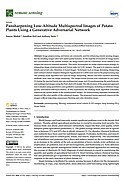Paper in Remote Sensing publiziert / Paper published in Remote Sensing [05.03.24]
Arbeit zu Pansharpening von Sourav Modak, Jonathan Heil und Anthony Stein wurde im MDPI-Journal Remote Sensing publiziert. - Work on pansharpening by Sourav Modak, Jonathan Heil and Anthony Stein was published in the MDPI journal Remote Sensing.ENGLISH VERSION BELOW
Das Paper "Pansharpening Low-Altitude Multispectral Images of Potato Plants Using a Generative Adversarial Network" von Sourav Modak, Jonathan Heil und Anthony Stein wurde im MDPI-Journal Remote Sensing publiziert. Es wird darin beschrieben, wie multispektrale Drohnenaufnahmen, die in einer geringen Flughöhe aufgenommen wurden, mittels eines Generative Adversarial Networks verbessert werden können. Zudem wurden klassische Image Preprocessing Methoden verwandt.
Link zum Paper: https://www.mdpi.com/2072-4292/16/5/874
Abstract: "Image preprocessing and fusion are commonly used for enhancing remote-sensing images, but the resulting images often lack useful spatial features. As the majority of research on image fusion has concentrated on the satellite domain, the image-fusion task for Unmanned Aerial Vehicle (UAV) images has received minimal attention. This study investigated an image-improvement strategy by integrating image preprocessing and fusion tasks for UAV images. The goal is to improve spatial details and avoid color distortion in fused images. Techniques such as image denoising, sharpening, and Contrast Limited Adaptive Histogram Equalization (CLAHE) were used in the preprocessing step. The unsharp mask algorithm was used for image sharpening. Wiener and total variation denoising methods were used for image denoising. The image-fusion process was conducted in two steps: (1) fusing the spectral bands into one multispectral image and (2) pansharpening the panchromatic and multispectral images using the PanColorGAN model. The effectiveness of the proposed approach was evaluated using quantitative and qualitative assessment techniques, including no-reference image quality assessment (NR-IQA) metrics. In this experiment, the unsharp mask algorithm noticeably improved the spatial details of the pansharpened images. No preprocessing algorithm dramatically improved the color quality of the enhanced images. The proposed fusion approach improved the images without importing unnecessary blurring and color distortion issues."
--
The paper "Pansharpening Low-Altitude Multispectral Images of Potato Plants Using a Generative Adversarial Network" by Sourav Modak, Jonathan Heil and Anthony Stein was published in the MDPI journal Remote Sensing. It describes how multispectral drone images taken at a low altitude can be enhanced using a Generative Adversarial Network. In addition, classical image preprocessing methods were used.
Link to the paper: https://www.mdpi.com/2072-4292/16/5/874
Abstract: "Image preprocessing and fusion are commonly used for enhancing remote-sensing images, but the resulting images often lack useful spatial features. As the majority of research on image fusion has concentrated on the satellite domain, the image-fusion task for Unmanned Aerial Vehicle (UAV) images has received minimal attention. This study investigated an image-improvement strategy by integrating image preprocessing and fusion tasks for UAV images. The goal is to improve spatial details and avoid color distortion in fused images. Techniques such as image denoising, sharpening, and Contrast Limited Adaptive Histogram Equalization (CLAHE) were used in the preprocessing step. The unsharp mask algorithm was used for image sharpening. Wiener and total variation denoising methods were used for image denoising. The image-fusion process was conducted in two steps: (1) fusing the spectral bands into one multispectral image and (2) pansharpening the panchromatic and multispectral images using the PanColorGAN model. The effectiveness of the proposed approach was evaluated using quantitative and qualitative assessment techniques, including no-reference image quality assessment (NR-IQA) metrics. In this experiment, the unsharp mask algorithm noticeably improved the spatial details of the pansharpened images. No preprocessing algorithm dramatically improved the color quality of the enhanced images. The proposed fusion approach improved the images without importing unnecessary blurring and color distortion issues."


